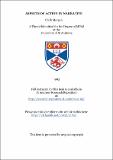Aspects of action in narrative
Abstract
The purpose of this thesis is to describe the way in which "unified action" functions within stories. Taking Aristotle's Poetics as a point of departure, the first chapter defines unified action as a disturbance, problem, and resolution. It draws extensively on the Knight's Tale and Heart of Darkness, among others, to illustrate these concepts. The above two stories are further compared with Sir Gawain and the Green Knight and two novels by Dostoevsky. The comparison shows how a story's themes lie in the circumstances of the disturbance and are worked out through action. This discussion leads to an examination of the causes of action. The aim of unified action is to release powerful emotions in the audience such as pity and terror. Aristotle found that such release results when the audience can see how previous events in the plot cause subsequent events. He argued that the most effective plot-structures, then, would avoid using nonhuman causes, such as chance. The plot of the Reeve's Tale is a near-perfect realization of such a structure. Nevertheless, a close examination of stories such as the folktale "The Happy Man's Shirt", and O'Connor's "A Good Man Is Hard to Find", reveals that plot-structures with non-human causes can also release powerful emotions. The discussion indicates that release depends more on "fallibility", or the protagonist's complicity, in his or her own fate than on a lucid cause-and-effect sequence. The final chapter is an extended examination of action's place in The Unbearable Lightness of Being and Heart of Darkness. It uses the concepts set out in the first two chapters to define the action, identify themes, and account for the unity of each story. Even in such complex works, action forms a narrative core which provides keys for grasping the total structure of the novels.
Type
Thesis, MPhil Master of Philosophy
Collections
Items in the St Andrews Research Repository are protected by copyright, with all rights reserved, unless otherwise indicated.

